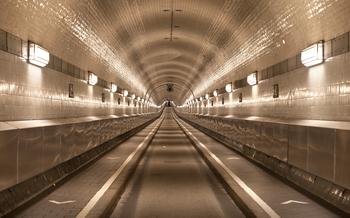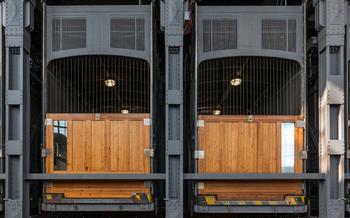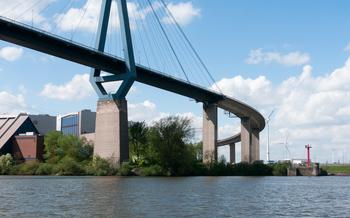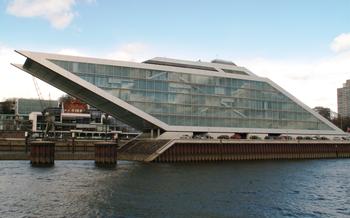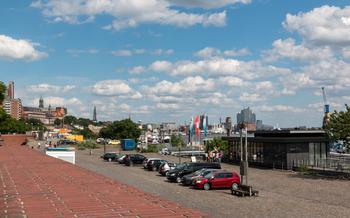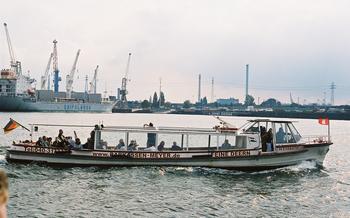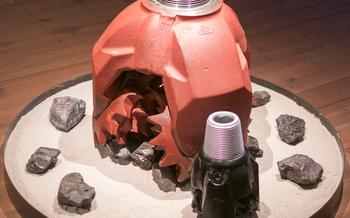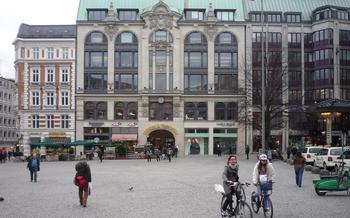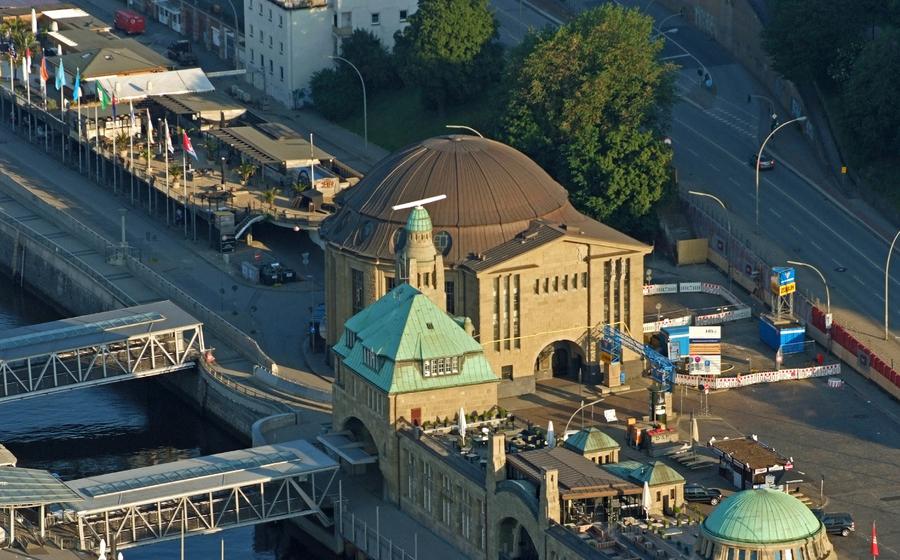
Hamburg's Old Elbe Tunnel
- Hamburg's Old Elbe Tunnel: An Architectural Masterpiece
- A Journey Through Time: The Elbe Tunnel's History
- Unveiling the Layers: What to See Inside the Tunnel
- A Walk Beneath the River: Experiencing the Tunnel on Foot
- A Drive Through History: Traversing the Tunnel by Vehicle
- A Multifaceted Destination: The Tunnel's Varied Uses
- A Tale of Two Tunnels: Comparing the Old and New Elbe Tunnels
- Engineering Marvels: The Technology Behind the Tunnel's Success
- A Symbol of Resilience: The Tunnel During World War II
- A New Lease on Life: The Tunnel's Restoration and Preservation
- A Memorable Experience: Tips for Visiting the Tunnel
- Unveiling Hidden Gems: Exploring Hamburg's Other Tunnels
- Embracing the Maritime Heritage: Hamburg's Connection to the Sea
- Hamburg's Vibrant Cultural Scene: Beyond the Tunnels
- Insider Tip: Uncovering the Tunnel's Secrets
Hamburg's Old Elbe Tunnel: An Architectural Masterpiece
A symbol of Hamburg's maritime heritage and a testament to 19th-century engineering prowess, the Old Elbe Tunnel stands as a remarkable architectural feat. Constructed between 1907 and 1911, this underwater passageway was a groundbreaking achievement, connecting the city center with the southern district of Steinwerder beneath the mighty Elbe River.
The tunnel's unique design, employing four massive tunnel shafts sunk into the riverbed, showcased the city's commitment to innovation and infrastructure development. Its construction involved the use of caissons and compressed air, pioneering techniques that allowed workers to labor in the challenging underwater environment.
As a testament to its enduring legacy, the Old Elbe Tunnel has become an iconic landmark of Hamburg, attracting visitors and locals alike. Its distinctive brick facade, adorned with intricate reliefs and sculptures, reflects the city's rich maritime history and its enduring fascination with the sea.
A Journey Through Time: The Elbe Tunnel's History
The Elbe Tunnel, a testament to human ingenuity and engineering prowess, has a rich and captivating history. Its conception can be traced back to the late 19th century when Hamburg, a thriving port city, faced the challenge of connecting its rapidly expanding neighborhoods on either side of the Elbe River. The idea of an underwater tunnel emerged as a bold solution to this geographical constraint.
In 1907, after years of planning and preparation, the construction of the tunnel commenced. Using innovative techniques and state-of-the-art machinery, engineers embarked on the ambitious task of excavating a passageway beneath the riverbed. The process involved employing caissons, massive watertight chambers, to create a dry working environment and protect against water infiltration.
On September 24, 1911, the Elbe Tunnel was officially inaugurated, marking a significant milestone in Hamburg's history. The tunnel quickly became a vital transportation link, facilitating the movement of people and goods between the city's districts. It played a crucial role in the city's economic growth and development, fostering trade and commerce.
The Elbe Tunnel's early years were marked by its successful operation and growing popularity. However, its existence was severely tested during World War II when Hamburg became a target of Allied air raids. The tunnel sustained significant damage, including structural cracks and flooding. Despite the challenges, the tunnel remained operational throughout the war, serving as a vital evacuation route for civilians seeking shelter from the relentless bombing.
After the war, the Elbe Tunnel underwent extensive repairs and restoration, demonstrating the city's unwavering commitment to preserving its heritage. The tunnel emerged from this period with renewed vigor, ready to serve Hamburg's transportation needs for decades to come.
Unveiling the Layers: What to See Inside the Tunnel
Descending into the Old Elbe Tunnel is like embarking on a journey through time and engineering. The tunnel's interior is a fascinating fusion of history, technology, and art, showcasing the ingenuity and perseverance of its creators.
The most striking feature of the tunnel is its four massive tunnel shafts, each a testament to the engineering marvel that this structure represents. Constructed using cast iron segments, these shafts form the foundation of the tunnel, providing structural support and ensuring its stability.
The tunnel's ventilation system is another marvel of engineering. Designed to maintain a constant flow of fresh air throughout the tunnel, this system was crucial for ensuring the safety and comfort of those using the tunnel. It features a series of ventilation shafts that extend above the ground, allowing fresh air to circulate and remove any fumes or pollutants.
As you walk through the tunnel, you'll notice the pedestrian walkway, a designated path for those on foot or cycling. This walkway is lined with ceramic tiles, each adorned with intricate designs and patterns that add a touch of elegance to the tunnel's interior.
Finally, the vehicle roadway, once bustling with horse-drawn carriages and early automobiles, now serves as a passageway for modern vehicles. The roadway is paved with cobblestones, a reminder of the tunnel's historic roots.
A Walk Beneath the River: Experiencing the Tunnel on Foot
As you descend the steps leading to the pedestrian walkway, a unique and captivating atmosphere envelops you. The air is cool and humid, carrying the faint scent of the river and the distant sounds of traffic above. The play of light and shadow creates an ethereal ambiance, with the flickering lights of the tunnel reflecting off the damp walls.
The pedestrian walkway is narrow, allowing for only single-file passage. As you walk, the walls seem to close in, creating a sense of intimacy and seclusion. The sounds of the river and the traffic above become more distinct, a symphony of rushing water, rumbling engines, and distant horns.
With each step, you feel the weight of history beneath your feet. This tunnel, a marvel of engineering, has stood the test of time, bearing witness to countless journeys and transformations. The sense of history is palpable, as you imagine the millions of people who have walked these same steps before you, from sailors and merchants to commuters and tourists.
As you emerge from the tunnel, blinking in the sudden brightness, you carry with you a newfound appreciation for this architectural masterpiece. The Elbe Tunnel is not just a passageway beneath the river; it is a living testament to Hamburg's rich history, maritime heritage, and enduring spirit.
A Drive Through History: Traversing the Tunnel by Vehicle
Driving through the Old Elbe Tunnel is an experience like no other. The narrow passageways, steep gradients, and low ceilings create a sense of being in a different world. The walls are lined with tiles that reflect the light of the headlights, creating a mesmerizing play of shadows. The sound of the engine echoes through the tunnel, accompanied by the rumble of traffic above.
As you descend into the tunnel, the world outside fades away, replaced by the unique atmosphere of the underground passage. The feeling of being beneath the river is palpable, and the views of the Elbe and the city from the tunnel's windows are breathtaking. Driving through the Old Elbe Tunnel is a journey through time, a chance to experience a piece of Hamburg's history and engineering prowess firsthand.
A Multifaceted Destination: The Tunnel's Varied Uses
The Hamburg Old Elbe Tunnel serves multiple purposes, catering to various needs and interests. Its primary function remains transportation, providing a vital link between the city center and the southern banks of the Elbe River. Both vehicles and pedestrians can traverse the tunnel, ensuring seamless movement across the river.
Beyond its practical function, the tunnel has become a popular tourist attraction, drawing visitors from around the world. Its unique architecture and historical significance make it a must-see destination for anyone interested in engineering marvels and maritime heritage. Guided tours are available, offering insights into the tunnel's construction, operation, and role in the city's history.
The tunnel's distinctive atmosphere and visual appeal have also made it a sought-after filming location for movies, TV shows, and commercials. Its underground setting, combined with its historic charm, creates a captivating backdrop for various productions, adding a touch of authenticity and intrigue to the stories they tell.
Furthermore, the tunnel has been used for art exhibitions and installations, transforming its utilitarian spaces into a unique venue for artistic expression. Local and international artists have showcased their works within the tunnel, creating immersive experiences that blend art, history, and engineering in unexpected and thought-provoking ways.
A Tale of Two Tunnels: Comparing the Old and New Elbe Tunnels
The Old Elbe Tunnel and the New Elbe Tunnel stand as testaments to Hamburg's engineering prowess and its enduring connection to the Elbe River. While both tunnels serve the purpose of connecting the city's northern and southern shores, they present distinct characteristics that reflect the evolving needs and technological advancements of their respective eras.
The Old Elbe Tunnel, completed in 1911, is a marvel of early 20th-century engineering. Its four cast-iron shafts and pedestrian walkways exude a timeless charm, while its ventilation system and vehicle roadway showcase the ingenuity of its designers. The tunnel's historic significance and unique atmosphere make it a beloved landmark and a popular tourist destination.
In contrast, the New Elbe Tunnel, opened in 1975, represents a more modern approach to tunnel construction. Its sleek, concrete structure and efficient design reflect the advances made in engineering and construction techniques over the decades. The New Elbe Tunnel features two separate tunnels for vehicles and pedestrians, allowing for smoother traffic flow and safer crossings.
Despite their differences, the Old and New Elbe Tunnels share several similarities. Both are immersed beneath the Elbe River, connecting the city's northern and southern districts. They also serve as vital transportation links, facilitating the movement of vehicles and pedestrians across the river.
The two tunnels stand as symbols of Hamburg's maritime heritage and its commitment to innovation. They have played a crucial role in shaping the city's infrastructure and connecting its diverse neighborhoods. Whether traversing the Old Elbe Tunnel's historic passageways or driving through the New Elbe Tunnel's modern arteries, visitors can experience Hamburg's rich engineering legacy and its enduring connection to the mighty Elbe River.
Engineering Marvels: The Technology Behind the Tunnel's Success
The construction of the Hamburg Old Elbe Tunnel was a testament to the engineering prowess of the late 19th century. Several innovative techniques were employed to overcome the challenges of building a tunnel beneath a major river.
The tunnel's design was revolutionary for its time. Instead of a single, large tunnel, it consisted of four separate shafts, each with its own pedestrian walkway and roadway. This design allowed for simultaneous construction and reduced the risk of flooding.
The use of caissons and compressed air was crucial to the tunnel's success. Caissons, essentially large underwater chambers, were sunk into the riverbed using compressed air to keep the water out. Workers inside the caissons excavated the tunnel and constructed the tunnel walls.
The challenges of underwater construction were immense. The riverbed was soft and unstable, and the water pressure was enormous. The engineers had to constantly monitor and adjust the air pressure in the caissons to prevent them from collapsing.
Despite the challenges, the Hamburg Old Elbe Tunnel was completed in 1911, a remarkable feat of engineering that continues to impress visitors to this day. The tunnel's innovative design and construction methods have stood the test of time, making it a testament to the ingenuity and skill of the engineers who built it.
A Symbol of Resilience: The Tunnel During World War II
The Hamburg Old Elbe Tunnel, a testament to engineering prowess, played a crucial role during the tumultuous period of World War II. Its strategic location beneath the Elbe River made it a vital artery for transportation and communication, connecting the city center with the southern neighborhoods. Despite the relentless Allied bombing campaigns that ravaged Hamburg, the tunnel remained largely intact, serving as a lifeline for the city's population.
The tunnel provided a safe passage for civilians seeking shelter from the aerial bombardments. Its sturdy construction and underground location offered protection from the destructive force of the bombs, saving countless lives. The tunnel also served as a vital route for transporting goods, supplies, and personnel, ensuring the city's continued functioning amidst the chaos of war.
Remarkably, the tunnel sustained only minor damage during the war, a testament to its robust engineering and the resilience of its construction. The few breaches that occurred were swiftly repaired, ensuring the tunnel's uninterrupted operation throughout the conflict. The tunnel's steadfastness during this challenging period further solidified its status as a symbol of Hamburg's unwavering spirit and determination to persevere.
In the aftermath of the war, the tunnel played a pivotal role in the reconstruction of Hamburg. It facilitated the transportation of building materials, equipment, and workers, enabling the city to rebuild its shattered infrastructure and restore its former glory. The tunnel's resilience and enduring functionality epitomized the indomitable spirit of Hamburg, a city that rose from the ashes of war to reclaim its position as a thriving metropolis.
A New Lease on Life: The Tunnel's Restoration and Preservation
Over the decades, the ravages of time, water, and traffic took their toll on the tunnel, necessitating a comprehensive restoration project. In the late 20th century, concerns grew about the tunnel's structural integrity and the need to preserve its historical significance.
The restoration project, undertaken in the 1990s, was a major undertaking that required meticulous planning and engineering expertise. The challenges were many: maintaining the tunnel's original appearance while upgrading its safety features, ensuring minimal disruption to traffic flow, and addressing the unique challenges of working in a confined underwater environment.
Through careful restoration techniques and the use of modern materials, the tunnel's structural integrity was reinforced, its ventilation system was improved, and its lighting was upgraded. The original tiles and brickwork were meticulously restored, and new safety features were seamlessly integrated into the tunnel's design.
The successful restoration project breathed new life into the tunnel, ensuring its continued use and enjoyment for generations to come. Today, the Hamburg's Old Elbe Tunnel stands as a testament to the city's commitment to preserving its architectural heritage while embracing modern advancements. It remains a beloved landmark and a symbol of Hamburg's enduring maritime spirit.
A Memorable Experience: Tips for Visiting the Tunnel
Planning a visit to the Hamburg's Old Elbe Tunnel promises a unique and memorable experience. To make the most of your visit, here are some insider tips to guide you:
-
Plan Your Visit: Before embarking on your journey, check the tunnel's opening hours and admission fees. Plan your visit accordingly to avoid any inconveniences.
-
Choose Your Mode of Transport: The tunnel offers three distinct ways to explore its depths. You can walk, cycle, or drive through it. Each mode of transport provides a different perspective, so choose the one that best suits your preference.
-
Explore the Surroundings: The tunnel is situated in a vibrant neighborhood with plenty to offer. Take some time to explore the nearby Elbe River promenade, which offers stunning views of the river and the city skyline.
-
Capture the Moment: The tunnel's unique atmosphere and architectural details make it a photographer's paradise. Don't forget to bring your camera or smartphone to capture these memorable moments.
Unveiling Hidden Gems: Exploring Hamburg's Other Tunnels
Beyond the Old Elbe Tunnel, Hamburg boasts a network of lesser-known tunnels that offer unique perspectives on the city's subterranean infrastructure. Each tunnel serves a distinct purpose, contributing to the efficient functioning and rich history of Hamburg.
The Alster Tunnel, situated beneath the picturesque Alster River, is a pedestrian and cycling tunnel that connects the city center with the trendy district of Winterhude. Opened in 1962, the tunnel offers a scenic subterranean route, allowing visitors to traverse the river without crossing any bridges.
The S-Bahn Tunnels, part of the city's extensive rapid transit system, crisscross beneath Hamburg, connecting different neighborhoods and providing convenient transportation. These tunnels, often adorned with colorful graffiti, offer a glimpse into the city's underground transportation network.
The Port Tunnels play a crucial role in facilitating the movement of goods and vehicles within the Port of Hamburg, one of the largest in Europe. These tunnels, constructed to accommodate the massive flow of cargo and traffic, provide a vital link between the port and the city's transportation infrastructure.
Exploring these hidden tunnels provides an opportunity to delve deeper into Hamburg's urban fabric and appreciate the engineering marvels that contribute to its smooth operation. Whether you're a history buff, an architecture enthusiast, or simply curious about the city's hidden gems, Hamburg's other tunnels await your discovery.
Embracing the Maritime Heritage: Hamburg's Connection to the Sea
Hamburg's rich maritime heritage is deeply intertwined with its geography, history, and culture. Situated on the banks of the Elbe River, which flows into the North Sea, Hamburg has long been a major port city, serving as a gateway for trade and commerce with the rest of the world.
The Elbe River has played a pivotal role in shaping Hamburg's destiny. It has facilitated the city's growth as a trading hub, connecting it to the vast network of waterways and ports across Europe. The river has also been a source of livelihood for many Hamburg residents, with fishing, shipbuilding, and maritime trade forming important pillars of the city's economy.
Hamburg's maritime heritage is reflected in its many attractions and landmarks. The iconic Hamburg Port, with its bustling container terminals and historic warehouses, is a testament to the city's enduring connection to the sea. The International Maritime Museum, located in a former warehouse on the waterfront, showcases a vast collection of maritime artifacts, models, and exhibits, offering visitors a glimpse into the city's rich maritime past.
The city's passion for sailing, shipbuilding, and water sports is evident in its vibrant maritime culture. Hamburg is home to several sailing clubs and marinas, and the annual Hamburg Sailing Week, held in August, attracts sailing enthusiasts from around the world. The city's shipyards have a long history of building ships, from traditional sailing vessels to modern-day container ships, contributing to Hamburg's reputation as a center of shipbuilding excellence.
Hamburg's maritime heritage is not just a matter of history; it is a living and breathing part of the city's identity. The river, the port, and the maritime industries continue to play a vital role in the city's economy and culture, ensuring that Hamburg remains a vibrant and dynamic maritime hub.
Hamburg's Vibrant Cultural Scene: Beyond the Tunnels
Beyond its impressive tunnels, Hamburg is renowned for its vibrant cultural scene. The city boasts a rich artistic heritage, with numerous museums, theaters, and concert halls showcasing a diverse range of performances and exhibitions. Art enthusiasts can explore the Kunsthalle Hamburg, renowned for its collection of paintings from the Middle Ages to the present day. The Deichtorhallen, housed in a former warehouse district, hosts contemporary art exhibitions and cultural events.
Music lovers will delight in the Hamburg State Opera, known for its world-class opera productions. The Elbphilharmonie, a stunning concert hall with a unique glass façade, offers a breathtaking venue for classical and contemporary concerts. Hamburg also boasts a thriving theater scene, with stages catering to various tastes, from traditional plays to avant-garde performances.
When the sun sets, Hamburg transforms into a vibrant nightlife destination. The Reeperbahn, known as the city's red-light district, offers a diverse mix of bars, clubs, and live music venues. The Schanzenviertel, a trendy neighborhood, is home to alternative bars, independent music venues, and cozy cafés. For a more sophisticated evening, visitors can indulge in fine dining at one of Hamburg's many Michelin-starred restaurants, savoring the city's culinary delights.
Insider Tip: Uncovering the Tunnel's Secrets
To fully immerse yourself in the rich history and engineering marvels of the Hamburg's Old Elbe Tunnel, consider embarking on a guided tour. These informative tours, led by knowledgeable experts, provide a deeper understanding of the tunnel's construction, operation, and significance. You'll gain insights into the challenges faced by the engineers, the innovative techniques employed, and the role the tunnel has played in Hamburg's development.
For photography enthusiasts, the tunnel presents a treasure trove of unique angles and lighting conditions. Capture the interplay of light and shadow, the intricate details of the tunnel's architecture, and the mesmerizing reflections on the water's surface. Experiment with different perspectives and vantage points to create stunning images that encapsulate the tunnel's essence.
Finally, venture beyond the beaten path to discover hidden spots within the tunnel that offer a glimpse into its lesser-known stories. Explore the ventilation chambers, admire the intricate tilework, and uncover the secret passageways that were once used for maintenance and repairs. These hidden gems add an extra layer of intrigue and fascination to your exploration of the Hamburg's Old Elbe Tunnel.
